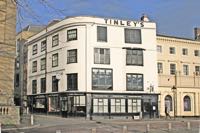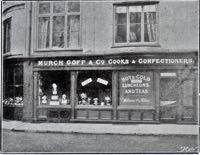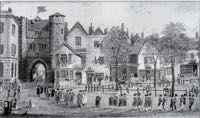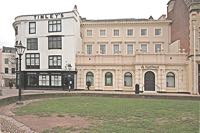
Tinley's Cafe, 2 Broadgate, Cathedral Yard
Now Pizza Express
Page updated 31st January 2018
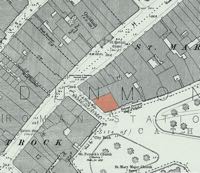 This tea shop and restaurant
served the people of
Exeter and visitors alike, for many years, from premises that give one
of the finest views of the Cathedral
there is. The history of the building is complex, as it was adjacent to the ancient Broadgate, demolished in 1824.
This tea shop and restaurant
served the people of
Exeter and visitors alike, for many years, from premises that give one
of the finest views of the Cathedral
there is. The history of the building is complex, as it was adjacent to the ancient Broadgate, demolished in 1824.
Situated on one side of Broadgate, parts of the rear interior of
Tinley's (Pizza Express) date from the 16th-century. The old Broadgate
and the timber fronted buildings on each
side were set back from Cathedral Yard. In the front of the timber framed buildings, there was, at a later date, constructed on the corner, a double storey shop.
The old Broadgate was demolished in December 1824 and the
carriageway
between the High Street and Cathedral Yard widened. The corner building
was reconstructed in 1825, with the
narrow front curving round to the side along the new Broadgate
thoroughfare. The adjacent single story shop was built over and blended
into the corner building in 1830 and is essentially the building as
seen today.
Before 1793, when it became a confectioner, the shop was occupied by James Upjohn, a watch maker. The premises changed ownership several times, as a confectioners, until 1829 when Miss Sarah Marden took on the business. In 1833 she married James Murch an accountant of St Martin's parish, and around about then the business became Murch's. Despite his profession, James Murch's father was a baker, allowing Murch's to claim in the 1882 they had been trading since 1780.
For a number of years during the 1840s and early 1850s, the premises to the right of Murch's were occupied by John Treadwin, a watchmaker. He married, in 1850, Charlotte Dobbs who went on to produce some of the highest quality Honiton lace in the country, from 5 Cathedral
Close, as Mrs Charlotte
Treadwin. The rear of the National Westminster Bank now occupies the site of Treadwin's watch business.
Murch's Restaurant
The first reference to Murch's, as a confectioners in the Flying Post, was an advert for a young person to manage a dairy and kitchen in 1849. Sarah Murch, widow, is listed in the 1861 census at the address as a confectioner. Her son James was working for her while her second son had become an ironmonger's assistant and her youngest child, Sarah was a shop assistant. James Murch, Sarah Murch's late husband had been a wine merchant (listed as an accountant for their wedding) in South Street until his death in 1854. In 1876, J C Goff married A Murch at St Martin's Church, although the two names would not be joined in business until 1882, when it became Murch Goff and Co.
An important part of the business was catering for wedding breakfasts, and supplying wedding cakes, judging by the many reports on local weddings. They became purveyors of Horniman's Tea and for some strange reason were agents for "... the magical polish for ballroom floors." Many adverts from the Edwardian period and First War show photos of Murch's Cathedral Restaurant and Cafe.
Arts and crafts
Murch and Goff closed in 1917, and in 1920, the premises became the Broadgate Mart, an antiques saleroom run by Mark Rowe and Co. The business did not last long and in1924, the premises became an arts and crafts business called Glebelands, after the Women's Institute purchased the building. Selling Honiton lace, pictures, jewelry, pottery, candies and toys, they were well placed to take advantage of the tourists visiting the Cathedral. A feature in the Exeter and Plymouth Gazette from 1924 stated:
In addition to the Gallery already opened for the Exhibition and Sale of Original and Hand Work of all kinds, the Organisers of Glebelands are opening a small CLUB for LADIES. The Motto of this small rendezvous is: "Thought, Culture, and Quietude/" There simple and comfortable accommodation most conveniently situated at the heart Exeter, and should be very useful to many people who come to the city for meetings, shopping, and other business. No formal "opening" has been arranged, as the very "Being" of this Club is "Quietude," but those to whom it will appeal are cordially invited to visit the premises from 2 p.m. to 4 p.m., when they may obtain all details from the Secretary, or to write for them. The premises Lounge, Drawing-room, a Writing-room, two small Tea-rooms, a rest-room, and two Dressing-rooms. .
Tinley's opens
It was in 1930 that Mrs Tinley opened her famous
tearooms and had the Tinley's sign fixed across the top of the
building. Luncheons in the 1930's cost 1s 4d and 1s
8d (about 7p and 8p) and people would drop in for a 'waffle and quick
lunch'. At first, the shop baked 2 dozen savories per day, but by 1965,
their bakery in Sidwell Street was
turning out 200 dozen! The bombing of 1942, spared many buildings in
Cathedral Close. However, the proximity of so many large explosions
caused movement in the upper floors and
Tinley's had to be evacuated to a new cafe in Blackboy Road, while the
building was reinforced with steel.
In 1961, Mr and Mrs Reginald Ellis took over the teashop, retaining
the
name, and in 1965 they opened their Sidwell Street premises. Another
change of ownership occurred in 1987
when Pascal and Jane Thomas took over, but after a dispute with their
landlords, the teashop finally closed as Tinley's in August 1992. In
March 1993 it reopened, named French
Sticks. Gone was the English style afternoon tea, and in was coffee,
croissants and French pastries. The new owners tried to introduce
tables on the pavement, but the City Council
saw fit to stop them, and within two years they had closed.
The premises were taken over by Pizza Express and Exeter
Archaeology
were called to investigate the premises before a refitting. They established
that the oldest parts of the building
dated from the 16th-century and there was no evidence of the old
Cathedral Close wall running through the building. After refurbishment,
Pizza Express were open for business in
1996. Pizza Express has done a good job at retaining many of the
features of the old building, and even their sign out side is nicely
subdued, while keeping the striking Tinley's
sign across the top of the building.
Source: Various sources including Gates of the Close by M Fodor and Exeter guidebooks from 1910 to 1930. Exeter City Council Timetrail, the Express and Echo, Flying Post and Dick Passmore.
│ Top of Page │
